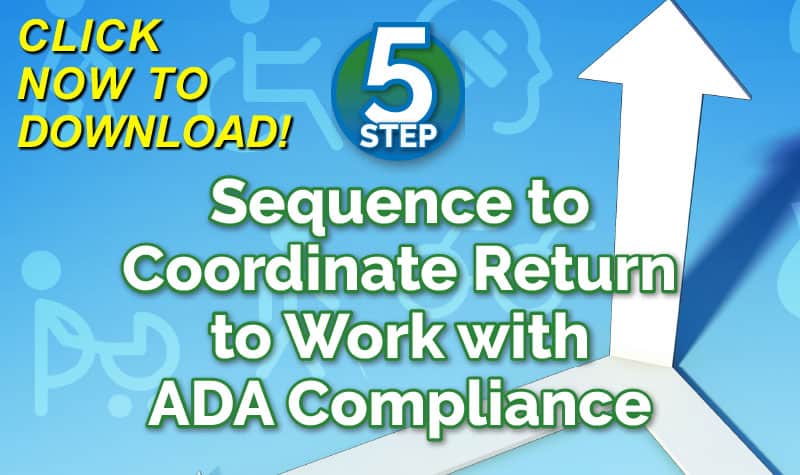
The first question from most employers when an employee suffers an injury is: How long will he/she be off work? Estimating the length of time the employee will be off work is not a precise science, but thanks to the accumulation of millions of workers compensation claims and disability cases over the years, there is ample data available to provide a range of time to predict how long it will take the employee to recover from a specific injury.
A large third party administrator can now estimate disability for any type of injury. Using the disability guidelines available, they can even refine the predicted period of disability using criteria of:
- Age
- Preexisting unrelated medical conditions
- Gender
- CPT codes (description of the services provided by the doctor)
- Zip codes
Click Link to Access Free PDF Download
“5-Step Sequence to Coordinate Return-to-Work with ADA Compliance”
While it almost sounds like you can plug the data into the computer and the computer will spit out the exact number of days the employee will be recovering from their injury, it is more complicated than that. There are numerous other factors that come into play when determining the period of time it will take the employee to recover from the injury including:
- The severity of the injury – for example a torn tendon can be a small partial tear, a larger tear or torn completely apart.
- The pre-injury condition of the employee – the physically fit recover faster than the employees who have poor physical conditioning.
- Other injuries – employees with only one injury in an accident recover faster than an employee with two or more injuries, for example one fracture bone as opposed to three broken bones.
- The post injury treatment program – employees who have physical therapy, occupational therapy or a rehabilitation program recover faster than employees with the same injury, but without a post injury treatment program.
- The personal habits of the employee – smoking, alcohol, and illicit drugs slow the recovery process.
- The employee’s stress level, sleeping habits and general health.
From the medical provider or adjuster’s standpoint, if asked to predict the length of time the employee will be recovering from an injury, they will turn to a source such as The Medical Disability Advisor for disability duration guideline tables to provide information about anatomical regions, diagnostic categories, medical specialists, job titles and ICD-9 Codes.
The data and the tables will provide general answers and assist in predicting the approximate length of disability. The period of disability should not be confused with the length of time the employee will be off work. In most cases, the injured employee can return to light duty or modified duty work before the period of disability is over. To determine if the employee can return to work before the employee is fully healed, the doctor will look at the employee’s physical limitations, the necessary restrictions and the employee’s ability to deal with the injury symptoms.
The physical limitations are often centered around the employee’s ability to use their musculoskeletal system. The employee will be given limitations on how much force they can exert or weight they can safely move, or how long they can stand, sit, squat, bend, crawl, etc. The limitations are designed to stop the employee from using an injured body part in a way that will aggravate the injured part, slowing or even reversing the recovery process.
The restrictions are designed to protect the employee, co-workers, and the general public from further injury that might occur when an employee is unable to safely perform the functions of the job. For example, while an employee might be physically capable of returning to work, an employee taking pain medication that creates drowsiness should not be operating machinery or driving a vehicle.
For the doctor, one of the most difficult aspects of controlling the period of disability and the return to work, is the employee’s ability to deal with the pain symptoms. Some employee’s tolerate an injury and the pain associated with it better than others. And while pain can be very real, it is often used as a crutch by people who do not want to return to work. A lack of job satisfaction, available income from workers’ comp or another source, the employee’s ability to find another job, the desired standard of living and the need for health insurance or other employer provided benefits, often have an impact on the perceived level of pain and the length of the disability period. A simple, no cost way to deal with pain that will work sometimes is for the employer to call the employee and stress how much the employee is needed at work – making sure to let them know they are a necessary part of the workforce.
Author Rebecca Shafer, JD, President of Amaxx Risks Solutions, Inc. is a national expert in the field of workers compensation. She is a writer, speaker, and website publisher. Her expertise is working with employers to reduce workers compensation costs, and her clients include airlines, healthcare, printing, publishing, pharmaceuticals, retail, hospitality, and manufacturing. See www.LowerWC.com for more information. Contact: RShafer@ReduceYourWorkersComp.com.
Our WC Book: http://www.wcmanual.com
WORK COMP CALCULATOR: http://www.LowerWC.com/calculator.php
MODIFIED DUTY CALCULATOR: http://www.LowerWC.com/transitional-duty-cost-calculator.php
WC GROUP: http://www.linkedin.com/groups?homeNewMember=&gid=1922050/
SUBSCRIBE: Workers Comp Resource Center Newsletter
Do not use this information without independent verification. All state laws vary. You should consult with your insurance broker or agent about workers comp issues.
©2011 Amaxx Risk Solutions, Inc. All rights reserved under International Copyright Law. If you would like permission to reprint this material, contact Info@ReduceYourWorkersComp.com.







